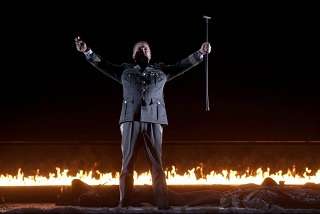|
Back
A Confusing Die Walküre Madrid
Teatro Real
02/12/2020 - & February 14, 16, 18, 21, 23, 25, 27, 28, 2020
Richard Wagner: Die Walküre
Ingela Brimberg/Ricarda Merbeth* (Brünnhilde), Christopher Ventris/Stuart Skelton* (Siegmund), Elisabet Strid/Adrianne Pieczonka* (Sieglinde), Ain Anger/René Pape* (Hunding), James Rutherford/Tomasz Koniezcny* (Wotan), Daniela Sindram (Fricka), Julie Davies (Gerhilde), Samantha Crawford (Ortlinde), Sandra Ferrández (Waltraute), Bernadette Fodor (Schwertleite), Daniela Köhler (Helmwige), Heike Grötzinger (Siegrune), Marifé Nogales (Grimgerde), Rosie Aldrige (Rossweise)
Orquesta Titular del Teatro Real (Orquesta Sinfónica de Madrid), Pablo Heras-Casado (conductor)
Robert Carsen (stage director), Patrick Kinmonth (sets & costumes), Manfred Voss (lighting)

T. Koniezcny (© Javier del Real/Teatro Real)
Following last season’s successful production of Das Rheingold, Teatro Real continues this season with Die Walküre. Robert Carsen’s stagings are always interesting and thought provoking. However, it was a bit confusing, as this production was not centered around ecology, as was Das Rheingold. The setting is transposed to World War II, but no major ideas come from this dramatic change. In Act I, Hunding is an arms dealer and his hut a squalid warehouse. The sword was not drawn by Siegmund from a tree but from a fallen trunk, not the loftiest of images. The opening of Act II is in a chic art nouveau salon, an emphasis on the disparity between the powerful and commoners. The warrior “Brünnhilde” is nonchalantly reading a magazine on a sofa. Wotan is an SS General whose spear is replaced by a walking cane, accentuating his weakness. In Act III, the Valkyries are dressed as working class housewives rather than warriors. They are collecting dead heroes among many frozen corpses and sending them off on a ladder to Walhalla. The final scene, the duet between Wotan and Brünnhilde is among the remaining frozen corpses, and the fire by which Wotan surrounds Brünnhilde is merely figurative. Some of these transformations are memorable for their extravagance and their visual effect. However, they are not always à propos.
It is hard to assemble an ideal cast for the opera as there are six major roles. Most convincing was Adrienne Pieczonka as Sieglinde, who had the appropriate voice for her role as well as excellent acting skills. She was able to convey the different moods of the character: misery, rapture and despair. Despite the public’s enthusiasm, Ricarda Merbeth’s Brünnhilde was less convincing. This was her debut in a role much heavier than her usual repertoire. While she does manage the notes, her limitations are apparent throughout the performance. Fortunately, she’s both an intelligent singer and an excellent actress. Stuart Skelton initially impressed with his ease in the upper register, but alas, his voice became progressively less powerful. Moreover, he lacked stage presence. Though his voice is not as fresh as years ago, René Pape’s Hunding was of the high standard one expects of the German bass. Mezzo Daniela Sindram was a convincing Fricka dramatically, but less so vocally. Her high notes sounded strained. Polish baritone Tomasz Konieczny was an excellent Wotan. His understanding of the role is obvious in his delivery and his German diction is impeccable. One may have wished for a deeper voice, but Koniezny manages to overcome his vocal limitations through his exceptional interpretation. Despite a few off notes, the Orquesta titular del Teatro Real was up to the challenge of performing this monumental work. Pablo Heras-Casado was able to bring out the textures and colours of Wagner’s music. Nonetheless, after last season’s excellent Das Rheingold, this was a rather disappointing Die Walküre.
Ossama el Naggar
|